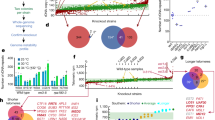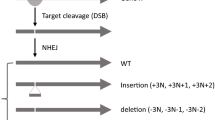Abstract
We report the construction and analysis of 4,836 heterozygous diploid deletion mutants covering 98.4% of the fission yeast genome providing a tool for studying eukaryotic biology. Comprehensive gene dispensability comparisons with budding yeast—the only other eukaryote for which a comprehensive knockout library exists—revealed that 83% of single-copy orthologs in the two yeasts had conserved dispensability. Gene dispensability differed for certain pathways between the two yeasts, including mitochondrial translation and cell cycle checkpoint control. We show that fission yeast has more essential genes than budding yeast and that essential genes are more likely than nonessential genes to be present in a single copy, to be broadly conserved and to contain introns. Growth fitness analyses determined sets of haploinsufficient and haploproficient genes for fission yeast, and comparisons with budding yeast identified specific ribosomal proteins and RNA polymerase subunits, which may act more generally to regulate eukaryotic cell growth.
This is a preview of subscription content, access via your institution
Access options
Subscribe to this journal
Receive 12 print issues and online access
$209.00 per year
only $17.42 per issue
Buy this article
- Purchase on Springer Link
- Instant access to full article PDF
Prices may be subject to local taxes which are calculated during checkout





Similar content being viewed by others
Change history
07 December 2010
In the version of this article initially published, the address of one of the authors, Young-Joo Jang, was incorrect. The correct address is Laboratory of Cell Cycle & Signal Transduction, WCU Department of NanoBioMedical Science, Institute of Tissue Regeneration Engineering, Dankook University, Cheonan, Korea.The error has been corrected in the HTML and PDF versions of the article.
References
Jorgensen, P. et al. High-resolution genetic mapping with ordered arrays of Saccharomyces cerevisiae deletion mutants. Genetics 162, 1091–1099 (2002).
Hillenmeyer, M.E. et al. The chemical genomic portrait of yeast: uncovering a phenotype for all genes. Science 320, 362–365 (2008).
Giaever, G. et al. Functional profiling of the Saccharomyces cerevisiae genome. Nature 418, 387–391 (2002).
Winzeler, E.A. et al. Functional characterization of the S. cerevisiae genome by gene deletion and parallel analysis. Science 285, 901–906 (1999).
Entian, K.D. & Kotter, P. Methods in Microbiology 36, edn. II. 629–666 (Elsevier, 2007).
Kittler, R. et al. Genome-scale RNAi profiling of cell division in human tissue culture cells. Nat. Cell Biol. 9, 1401–1412 (2007).
Wood, V. et al. The genome sequence of Schizosaccharomyces pombe. Nature 415, 871–880 (2002).
Fisk, D.G. et al. Saccharomyces cerevisiae S288C genome annotation: a working hypothesis. Yeast 23, 857–865 (2006).
Wach, A., Brachat, A., Pohlmann, R. & Philippsen, P. New heterologous modules for classical or PCR-based gene disruptions in Saccharomyces cerevisiae. Yeast 10, 1793–1808 (1994).
Gregan, J. et al. Novel genes required for meiotic chromosome segregation are identified by a high-throughput knockout screen in fission yeast. Curr. Biol. 15, 1663–1669 (2005).
Martin-Castellanos, C. et al. A large-scale screen in S. pombe identifies seven novel genes required for critical meiotic events. Curr. Biol. 15, 2056–2062 (2005).
Decottignies, A., Sanchez-Perez, I. & Nurse, P. Schizosaccharomyces pombe essential genes: a pilot study. Genome Res. 13, 399–406 (2003).
Smith, H.O., Hutchison, C.A. III, Pfannkoch, C. & Venter, J.C. Generating a synthetic genome by whole genome assembly: phiX174 bacteriophage from synthetic oligonucleotides. Proc. Natl. Acad. Sci. USA 100, 15440–15445 (2003).
Sipiczki, M. Where does fission yeast sit on the tree of life? Genome Biol. 1, reviews 1011.1–1011.4 (2000).
Wood, V. Schizosaccharomyces pombe comparative genomics; from sequence to systems, in Comparative Genomics: Using Fungi as Models (eds. Sunnerhagen, P. & Piskur, J.), 233–285 (Springer Berlin, Heidelberg, 2006).
Jeffares, D.C., Penkett, C.J. & Bahler, J. Rapidly regulated genes are intron poor. Trends Genet. 24, 375–378 (2008).
Matsuyama, A. et al. ORFeome cloning and global analysis of protein localization in the fission yeast Schizosaccharomyces pombe. Nat. Biotechnol. 24, 841–847 (2006).
Huh, W.K. et al. Global analysis of protein localization in budding yeast. Nature 425, 686–691 (2003).
Benton, M.J. & Ayala, F.J. Dating the tree of life. Science 300, 1698–1700 (2003).
Hoskin, C.J., Higgie, M., McDonald, K.R. & Moritz, C. Reinforcement drives rapid allopatric speciation. Nature 437, 1353–1356 (2005).
Harrison, R., Papp, B., Pal, C., Oliver, S.G. & Delneri, D. Plasticity of genetic interactions in metabolic networks of yeast. Proc. Natl. Acad. Sci. USA 104, 2307–2312 (2007).
Chiron, S., Suleau, A. & Bonnefoy, N. Mitochondrial translation: elongation factor tu is essential in fission yeast and depends on an exchange factor conserved in humans but not in budding yeast. Genetics 169, 1891–1901 (2005).
Choi, D.H., Oh, Y.M., Kwon, S.H. & Bae, S.H. The mutation of a novel Saccharomyces cerevisiae SRL4 gene rescues the lethality of rad53 and lcd1 mutations by modulating dNTP levels. J. Microbiol. 46, 75–80 (2008).
Ralph, E., Boye, E. & Kearsey, S.E. DNA damage induces Cdt1 proteolysis in fission yeast through a pathway dependent on Cdt2 and Ddb1. EMBO Rep. 7, 1134–1139 (2006).
Liu, C. et al. Cop9/signalosome subunits and Pcu4 regulate ribonucleotide reductase by both checkpoint-dependent and -independent mechanisms. Genes Dev. 17, 1130–1140 (2003).
Preuss, D., Mulholland, J., Franzusoff, A., Segev, N. & Botstein, D. Characterization of the Saccharomyces Golgi complex through the cell cycle by immunoelectron microscopy. Mol. Biol. Cell 3, 789–803 (1992).
Ayscough, K., Hajibagheri, N.M., Watson, R. & Warren, G. Stacking of Golgi cisternae in Schizosaccharomyces pombe requires intact microtubules. J. Cell Sci. 106, 1227–1237 (1993).
Roemer, T. et al. Large-scale essential gene identification in Candida albicans and applications to antifungal drug discovery. Mol. Microbiol. 50, 167–181 (2003).
Deutschbauer, A.M. et al. Mechanisms of haploinsufficiency revealed by genome-wide profiling in yeast. Genetics 169, 1915–1925 (2005).
Pierce, S.E. et al. A unique and universal molecular barcode array. Nat. Methods 3, 601–603 (2006).
Jozwiak, J., Jozwiak, S. & Wlodarski, P. Possible mechanisms of disease development in tuberous sclerosis. Lancet Oncol. 9, 73–79 (2008).
Cheng, K.W., Lahad, J.P., Gray, J.W. & Mills, G.B. Emerging role of RAB GTPases in cancer and human disease. Cancer Res. 65, 2516–2519 (2005).
McGowan, K.A. et al. Ribosomal mutations cause p53-mediated dark skin and pleiotropic effects. Nat. Genet. 40, 963–970 (2008).
Lum, P.Y. et al. Discovering modes of action for therapeutic compounds using a genome-wide screen of yeast heterozygotes. Cell 116, 121–137 (2004).
Roguev, A. et al. Conservation and rewiring of functional modules revealed by an epistasis map in fission yeast. Science 322, 405–410 (2008).
Dixon, S.J. et al. Significant conservation of synthetic lethal genetic interaction networks between distantly related eukaryotes. Proc. Natl. Acad. Sci. USA 105, 16653–16658 (2008).
Kamath, R.S. et al. Systematic functional analysis of the Caenorhabditis elegans genome using RNAi. Nature 421, 231–237 (2003).
Dietzl, G. et al. A genome-wide transgenic RNAi library for conditional gene inactivation in Drosophila. Nature 448, 151–156 (2007).
Ravi, D. et al. A network of conserved damage survival pathways revealed by a genomic RNAi screen. PLoS Genet. 5, e1000527 (2009).
Bahler, J. et al. Heterologous modules for efficient and versatile PCR-based gene targeting in Schizosaccharomyces pombe. Yeast 14, 943–951 (1998).
Moreno, S., Klar, A. & Nurse, P. Molecular genetic analysis of fission yeast Schizosaccharomyces pombe. Methods Enzymol. 194, 795–823 (1991).
Styrkarsdottir, U., Egel, R. & Nielsen, O. The smt-0 mutation which abolishes mating-type switching in fission yeast is a deletion. Curr. Genet. 23, 184–186 (1993).
Elble, R. A simple and efficient procedure for transformation of yeasts. Biotechniques 13, 18–20 (1992).
Boyle, E.I. et al. GO:TermFinder–open source software for accessing Gene Ontology information and finding significantly enriched Gene Ontology terms associated with a list of genes. Bioinformatics 20, 3710–3715 (2004).
Acknowledgements
We thank members of our laboratories for their participation in the construction and analysis of the deletion mutants, particularly H.-R. Hwang, H.-S. Ahn, Y.-D. Kim, S. Park, H.-J. Lee, J.-H. Ahn, Y.-S. Kil, S.-Y. Park, J.-H. Lim, J.-H. Song, Y.-K. Ryoo, J.-Y. Kim, M.-J. Oh, S. Kong, J. Ahn, N. Sun, N. Peat, R. Mandeville and J.-J. Li. We also thank J.-H. Roe and W.-K. Huh for reading this manuscript and for their insightful comments and O. Nielsen for his patience with the many requests for pON177. This work was supported by the intramural research program of KRIBB (Mission 2007), the Chemical Genomics Research Program and the 21st Century Frontier Research Program from the Ministry of Education, Science and Technology (MOEST) of Korea. This work was also supported by Bioneer Corp., The Wellcome Trust, Cancer Research UK, The Breast Cancer Research Foundation (BCRF) and The Rockefeller University.
Author information
Authors and Affiliations
Contributions
D.-U.K., J.H., H.-O.P., M.W., H.-S.Y., P.N. and K.-L.H. conceived the project; D.-U.K., J.H., D.K., V.W., M.W., T.D., M.N., G.P., S.H., L.J., S.-T.B., H.L., Y.S.S., M.L., L.K., K.-S.H., E.J.N., A.-R.L., Y.-J.J., K.-S.C., S.-J.C., J.-Y.P., Y.P., H.M.K., S.-K.P., H.B.K., H.-S.K., H.-M.P., K.K., K.S. and K.B.S. performed experiments and data analysis; D.K., H.-J.P., E.-J.K. and H.-M.P. performed primer design; D.K. and V.W. performed bioinformatics; D.-U.K., J.H., D.K., V.W., P.N. and K.-L.H. wrote the paper.
Corresponding author
Ethics declarations
Competing interests
The authors declare no competing financial interests.
Supplementary information
Supplementary Text and Figures
Supplementary Tables 2–10,12–14,18 Supplementary Figs. 1–10 and Supplementary Methods (PDF 4821 kb)
Supplementary Table 1
The 4,836 deletion set in fission yeast and its genome dataset as a reference (4,914) (XLS 2317 kb)
Supplementary Table 11
Spreadsheet of 2,438 'one to one' orthologous pairs in fission yeast and budding yeast (for details, see attached Excel file) (XLS 572 kb)
Supplementary Table 15
Growth fitness data of S. pombe heterozygous deletion mutants in rich YE media (XLS 1347 kb)
Supplementary Table 16
List of slow growers from the two yeasts, whose relative fitness is less than 0.97 (XLS 260 kb)
Supplementary Table 17
List of haploinsufficient (lowest 3% ranked by RF) and haploproficient (highest 3% ranked by RF) genes from the two yeasts in rich media (XLS 217 kb)
Supplementary Data 1
All the primer set for the construction of deletion strains (XLS 3027 kb)
Supplementary Data 2
Mapping of the deletions (PDF 19502 kb)
Supplementary Data 3
Sequence of KanMX4 (PDF 231 kb)
Supplementary Data 4
Design of Affymertix custom GeneChip (XLS 1653 kb)
Supplementary Data 5
Microarray data set for growth profiling (ZIP 10612 kb)
Rights and permissions
About this article
Cite this article
Kim, DU., Hayles, J., Kim, D. et al. Analysis of a genome-wide set of gene deletions in the fission yeast Schizosaccharomyces pombe. Nat Biotechnol 28, 617–623 (2010). https://doi.org/10.1038/nbt.1628
Received:
Accepted:
Published:
Issue Date:
DOI: https://doi.org/10.1038/nbt.1628
This article is cited by
-
The SAGA histone acetyltransferase module targets SMC5/6 to specific genes
Epigenetics & Chromatin (2023)
-
Multiple intermolecular interactions facilitate rapid evolution of essential genes
Nature Ecology & Evolution (2023)
-
acCRISPR: an activity-correction method for improving the accuracy of CRISPR screens
Communications Biology (2023)
-
Tfs1, transcription elongation factor TFIIS, has an impact on chromosome segregation affected by pka1 deletion in Schizosaccharomyces pombe
Current Genetics (2023)
-
A synthetic ‘essentialome’ for axenic culturing of ‘Candidatus Liberibacter asiaticus’
BMC Research Notes (2022)



